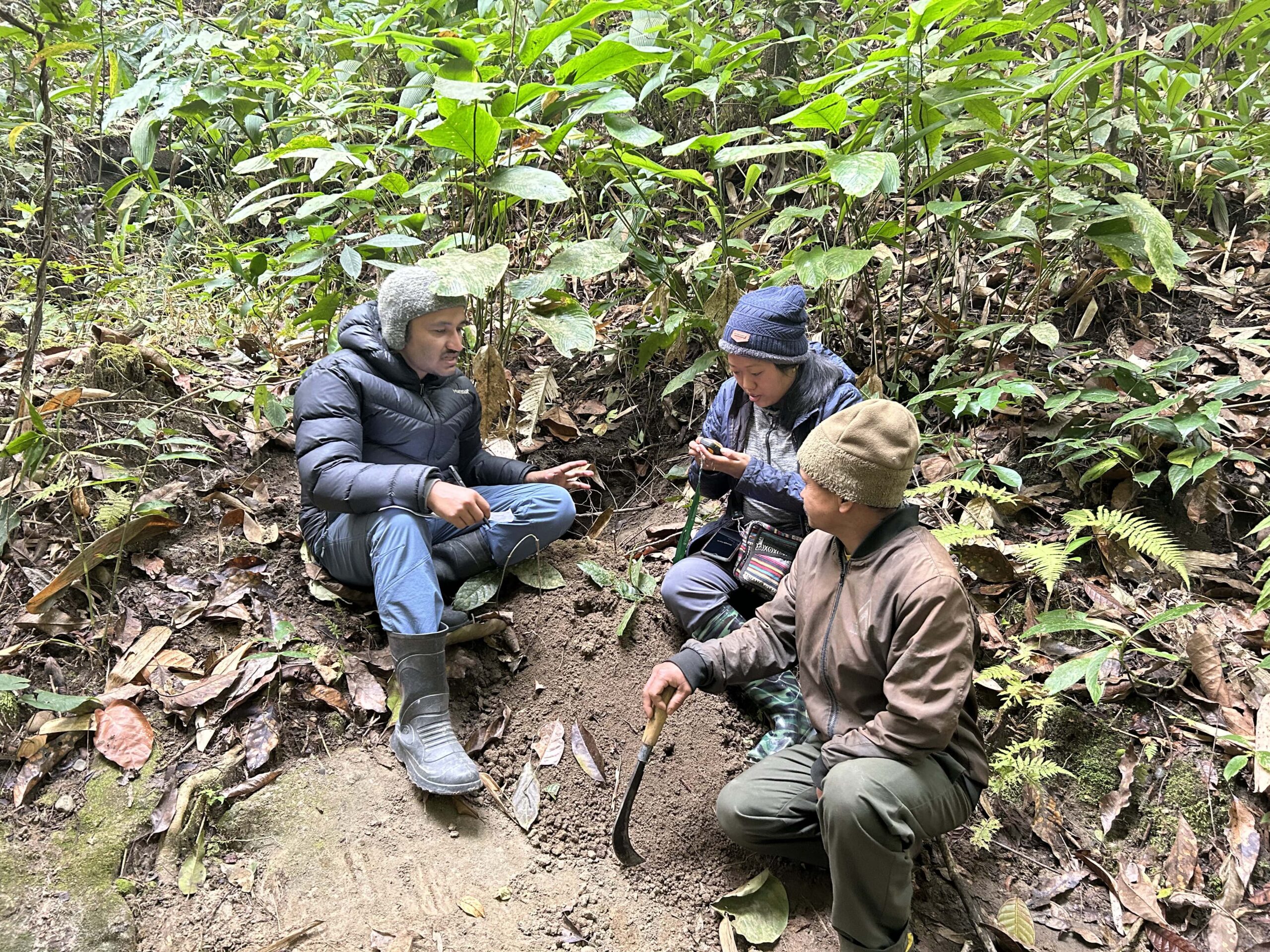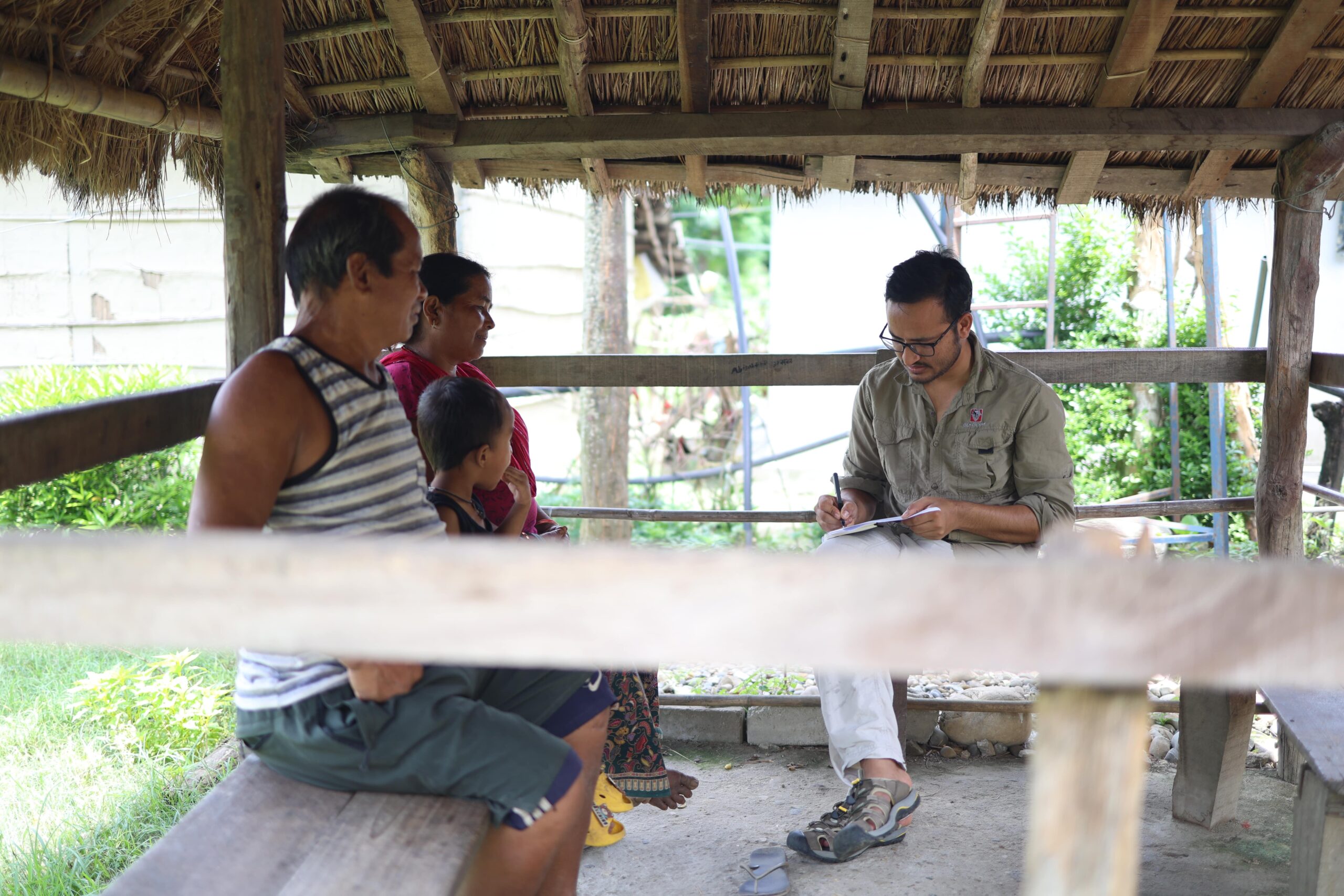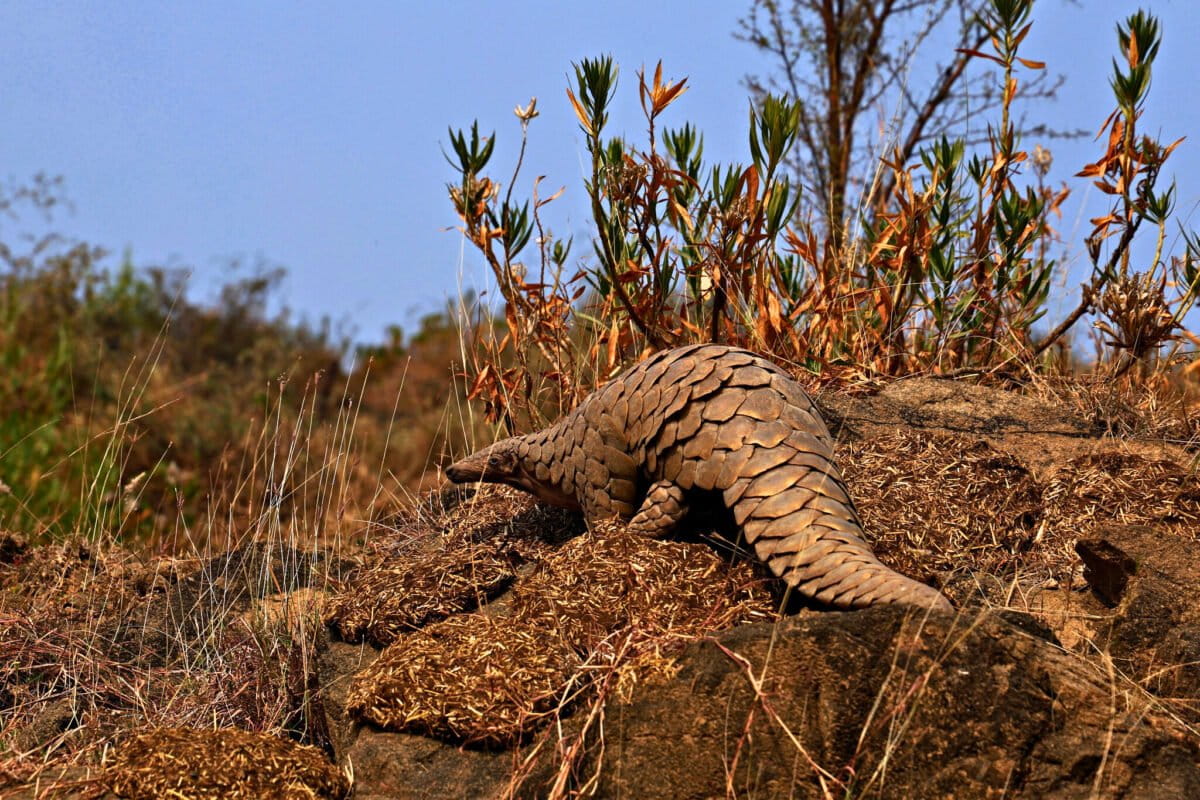Pangolins, the scaly anteaters that are the most trafficked wild mammals in the world, face a host of challenges throughout their range, including South Asia.The IUCN Pangolin Specialist Group is working on a global action plan to conserve the species, with different subgroups working on regional plans.After the plans are in place, the challenge will be to secure real-world funding to advance conservation efforts, says researcher Kumar Paudel, who leads the South Asia subgroup.
See All Key Ideas
KATHMANDU — Of the eight known species of pangolins found in Asia and Africa, three are listed as critically endangered on the Red List that’s maintained by the IUCN, the global wildlife conservation authority. Two of those three species of scaly anteaters are found in Nepal, where they’re officially accorded the highest level of protection for wildlife.
“It’s on a par with tigers and rhinos, but this legal status hasn’t translated into conservation investment or priority,” says Kumar Paudel, a pangolin researcher and founder of Greenhood Nepal, a conservation NGO.
That’s left Nepal’s pangolins, and indeed pangolins everywhere, highly threatened by the illegal trade for their meat and, in particular, their scales — prized in East Asia for their purported medicinal properties. Today, pangolins are known as the most trafficked wild mammals in the world. More than a million of the animals may have been “snatched from the wild” in the past decade, according to the IUCN’s Pangolin Specialist Group. Paudel, the group’s vice chair for Asia, says a significant proportion of that poaching and trafficking may have taken place in South Asia. This could be attributed to the region’s proximity to East and Southeast Asia, where demand is highest, he says.
 Conservationist and researcher Kumar Paudel (seated in the middle, extreme right) talks to community members about pangolins. Image courtesy of Kumar Paudel
Conservationist and researcher Kumar Paudel (seated in the middle, extreme right) talks to community members about pangolins. Image courtesy of Kumar Paudel
In 2016, the Pangolin Specialist Group came up with a global action plan focused on boosting knowledge of the species, curbing the illegal trade, identifying and managing habitats, and promoting community engagement.
This was followed by the inclusion of all eight species into Appendix I of CITES, the global wildlife trade convention, which bans the commercial trade of wild-caught individuals.
The group is now working on a global action plan to streamline pangolin conservation activities throughout its range, including coming up with plans tailored for different regions, including South Asia, led by Paudel. Mongabay’s Abhaya Raj Joshi interviewed Paudel in Kathmandu about the South Asia action plan and its different aspects. The following interview has been translated from Nepali and edited for clarity.
Mongabay: Let’s start with the latest update on the South Asia Pangolin Conservation Action Plan.
Kumar Paudel: We were supposed to organize an in-person meeting of stakeholders from across the region in Kathmandu recently. However, the meeting had to be called off at the last minute due to nationwide antigovernment protests in Nepal. We have not yet rescheduled the meeting.
Mongabay: At what stage of the process was the meeting being organized?
Kumar Paudel: The IUCN Pangolin Specialist Group is leading the technical planning, while Greenhood Nepal, where I serve as director, is facilitating the process by managing the logistics and resources required to get the plan drafted smoothly. The whole process is guided by the IUCN Conservation Planning Specialist Group, which has developed a process for preparing species conservation action plans.
As part of the process, we started out by identifying key stakeholders and launching a survey across six countries. We received responses from more than 100 researchers regarding threats and distribution of pangolins in South Asia. Then we conducted virtual sessions, a SWOT analysis, and carried out mapping exercises to identify viable populations. The next step was to organize an in-person meeting to put it all together and identify steps to take to save the pangolins.
Mongabay: What is the current state of national-level pangolin conservation action plans in South Asia?
Kumar Paudel: Work on national level action plans remains limited. Even Nepal’s national plan expired in 2022, and the government is yet to prepare a new one. While national plans are the government’s responsibility, the IUCN Pangolin Specialist Group focuses more on strategic planning and providing scientific, evidence-based policy recommendations that can serve as guiding documents for national plans.
 Kumar Paudel (left) with members of his research team looking at pangolin burrows in Nepal. Image courtesy of Kumar Paudel.
Kumar Paudel (left) with members of his research team looking at pangolin burrows in Nepal. Image courtesy of Kumar Paudel.
Mongabay: How did the specialist group realize the importance of regional action plans?
Within the specialist group we realized that a purely local or national approach is no longer sufficient to conserve pangolins, as it has become a transboundary issue. It isn’t enough for Nepal to do excellent work in places like Chitwan [National Park] if we ignore the external and shared threats from our neighbors. We need a broader approach similar to what has been successfully used for mega species such as tigers and elephants.
Pangolins are different from these mega species that move beyond borders. They have a limited home range, and generations after generations of pangolins live in the same area. Yet they are pervasive across South Asia and face similar threats across our borders.
For instance, we have reports of pangolin scales entering Nepal from outside, and there have been multiple seizures in India involving Nepali nationals. While mechanisms like the South Asia Wildlife Enforcement Network [SAWEN] exist for information exchange, we felt the need to prepare a dedicated regional strategy to address these complex, cross-border challenges.
This regional plan functions as a mid-level strategy: it sits between the global conservation plan and specific national action plans, bridging the gap to ensure regional cohesion.
Mongabay: Which are the countries included in the plan?
Kumar Paudel: Broadly, we are looking at the eight South Asian countries. However, the distribution varies. We have no official confirmation of pangolins in the Maldives. In Afghanistan, there are no verified reports, but we have records from the Afghanistan-Pakistan border area. India, Sri Lanka, Nepal, Bhutan and Bangladesh are also home to pangolins.
Mongabay: What is the timeline for the regional action plan?
Kumar Paudel: We are taking a long-term view based on biology. The average generation length of a pangolin is about six to seven years. To be effective, a conservation plan should cover at least three generations. We rounded this off to create a 25-year action plan, spanning from 2025 to 2050. We aim to finalize the plan by 2026, following in-person meetings to align civil society and prioritize actions for each stakeholder.
Mongabay: Research has shown that pangolins have an intricate relation with Indigenous communities. How does the action plan address this?
Kumar Paudel: South Asia is incredibly diverse, and pangolin habitats are deeply connected to Indigenous communities. Pangolins are elusive, range-restricted animals that often inhabit small, specific corners of hills where they persist for generations. Local knowledge is the key to finding them.
We have seen this work in practice. In northeastern India, camera trapping became much more effective when guided by local knowledge of exactly where the animals move. Similarly, in Chitwan National Park, we have seen that local communities are the primary source for identifying habitats over a three-year intervention. While high-level regional planning often excludes grassroots voices, we are making sure to map this connection because frontline researchers and enforcement rely heavily on this Indigenous expertise.
Mongabay: South Asian geopolitics can be tricky. Have you faced political hurdles in creating a cooperative regional plan?
Kumar Paudel: Surprisingly, the process has been quite optimistic. We requested nominations through SAWEN, and governments were responsive in nominating focal points. Perhaps because pangolins are not a “tourist-pulling” charismatic species like tigers, there is less political friction or diplomatic sensitivity. The plan will not be legally binding; rather, it is advisory. It provides guidance and inputs for policy harmonization. For example, when Nepal drafts its new national plan, this regional document will serve as a guiding framework.
 Kumar Paudel talksto community members about pangolins in Nepal. Image courtesy of Kumar Paudel.
Kumar Paudel talksto community members about pangolins in Nepal. Image courtesy of Kumar Paudel.
Mongabay: Pangolins have the highest legal protection, yet they remain the most trafficked mammal. How does the plan address this?
Kumar Paudel: This paradox is exactly why we need this plan. In South Asia, pangolins enjoy the highest legal protection. It is on par with tigers and rhinos, but this legal status hasn’t translated into conservation investment or priority.
There is a misconception that listing a species in CITES Appendix I means the job is done. In reality, an Appendix I listing is often an indicator of failure. It means we failed to manage the species when it was less threatened. Legal safeguards alone are not enough. We are seeing depletion rates of 80-90%, and South Asia is a major contributor to the illegal trade. We need to bridge the gap between “protected on paper” and “protected on the ground.”
Mongabay: The demand for its body parts is largely in Southeast Asia where traditional medicine is still practiced. Does this plan engage those stakeholders?
Kumar Paudel: This specific plan focuses on South Asia. The demand-side issues in Southeast Asia, driven largely by traditional medicine, are indeed massive. But it is beyond the scope of our plan.
It could be covered under separate Southeast Asian and global plans. Our goal is to clearly define and present the regional challenges specific to South Asia. These insights will then feed into the broader global strategy.
Mongabay: What is the biggest challenge moving forward after the plan is ready?
Kumar Paudel: It comes down to resources. The critical question is: Who invests? Everyone has an interest in saving the species, but clarifying who actually pays for the work is the challenge.
We need clear financial commitments. Hopefully, South Asian governments and conservation NGOs will recognize that despite the legal protection, funding is drastically needed to translate policy into real-world action. The action plan will suggest real-world actions based on science and evidence.
Species recovery is challenging and time-consuming, but I am very optimistic that, working together, we will be able to save viable wild populations of pangolins across South Asia.
Cover image: An indian pangolin (Manis crassicaudata) in Pakistan. Image courtesy of Kumar Paudel.
Introducing wildlife crime to Nepal’s law enforcement: Interview with Prasanna Yonzon
‘Sustainable livelihoods go a long way’: Q&A with pangolin expert Tulshi Suwal

